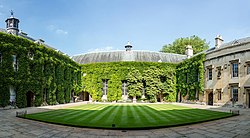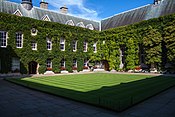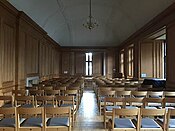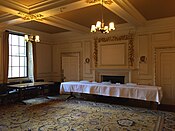Difference between revisions of "Lincoln College, Oxford"
(Created page with "{{Infobox college |name=Lincoln College |full name=The College of the Blessed Mary and All Saints, Lincoln |latin=Collegium Lincolniense |county=Oxfordshire |university=Oxford...") |
(No difference)
|
Latest revision as of 21:17, 15 March 2024
| Lincoln College Latin: Collegium Lincolniense
| |||||||||||||||||||

| |||||||||||||||||||
|---|---|---|---|---|---|---|---|---|---|---|---|---|---|---|---|---|---|---|---|
| Rector: | Prof. Henry Woudhuysen | ||||||||||||||||||
| Website: | www.lincoln.ox.ac.uk | ||||||||||||||||||
| |||||||||||||||||||
| Location | |||||||||||||||||||
| Grid reference: | SP51460632 | ||||||||||||||||||
| Location: | 51°45’12"N, 1°15’21"W | ||||||||||||||||||
Lincoln College (formally, The College of the Blessed Mary and All Saints, Lincoln) is one of the constituent colleges of the University of Oxford,[1] situated on Turl Street in central Oxford. Lincoln was founded in 1427 by Richard Fleming, the then Bishop of Lincoln.
Contents
History
Founding
Richard Fleming, the then Bishop of Lincoln, founded the college in order to combat the Lollard teachings of John Wyclif. He intended it to be "a little college of true students of theology who would defend the mysteries of Scripture against those ignorant laymen who profaned with swinish snouts its most holy pearls". To this end, he obtained a charter for the college from King Henry VI, which combined the parishes of All Saints, St Michael at the North Gate, and St Mildred's within the college under a rector. The college now uses All Saints Church as its library and has strong ties with St Michael's Church at the North Gate, having used it as a stand-in for the college chapel when necessary.[2]
Despite insufficient endowment and trouble from the Wars of the Roses (for their charter was from the deposed Lancastrian), the college has survived and flourished thanks to the efforts of its fellows and the munificence of a second bishop of Lincoln, Thomas Rotherham. Richard Fleming died in 1431, and the first rector, William Chamberleyn, in 1434, leaving the college with few buildings and little money. The second rector, John Beke, secured the college's safety by attracting donors. By 1436, the college had seven fellows. John Forest, Dean of Wells and a close friend of Beke's, donated such an amount that the college promised to recognise him as a co-founder; it did not keep this promise. His gifts saw the construction of a chapel, a library, hall and kitchen.[3] After a pointed sermon from the incumbent rector, Thomas Rotherham was compelled to give his support and effectively re-founded it in 1478, with a new charter from King Edward IV.
18th century
In the 18th century, Lincoln became the cradle of Methodism when John Wesley, a fellow there from 1726, held religious meetings with his brother Charles and the rest of Wesley's 'Holy Club', whom the rest of the university took to calling 'Bible-moths'. His appearances at College became less frequent after he departed for the Province of Georgia as a missionary chaplain in 1735. Indeed, he took to signing his publications as "John Wesley, Sometime Fellow of Lincoln College".[4] A portrait of him hangs in the Hall, and a bust overlooks the front quad. The room where he is believed to have worked is also named after him, and was renovated by American Methodists at the beginning of the 20th century.[5]
Rivalry
As is common with Oxford colleges, the college has a long-standing rivalry with neighbour Brasenose College (which was founded by a later bishop of Lincoln, William Smyth). The two colleges share a tradition revived annually on Ascension Day. The story goes that, centuries ago, as a mob chased students at the university through the town, the Lincoln porter allowed in the Lincoln students but refused entry to the Brasenose member, leaving him to the mercy of the mob. An alternative is that a Lincoln man bested a Brasenose man in a duel. Either episode resulted in the Brasenose student's death, and ever since, on Ascension Day, Lincoln College has invited in members of Brasenose College every year through the one door connecting the two colleges, for free beer as penance. Since the nineteenth century, the beer has been flavoured with ivy so as to discourage excessive consumption.[6]
Modern day
Academically, Lincoln was one of the top ten in the Norrington Table each year from 2006 to 2015 (excluding 2010 and 2011).[7][8] Lincoln ranked third in the Norrington Table in 2021[9] and second in 2022.[10]
The college is associated with the Goblin Club, an exclusive all-male dining society founded in 1902.[11] In May 2019, the JCR voted to extend a ban on the society on the grounds that it was perceived to be both elitist and racist.[12]
In 1958, the college was the first in Oxford or Cambridge to provide a Middle Common Room exclusively for the use of graduate students.[13][14] Like many of Oxford's colleges, Lincoln admitted its first mixed-sex cohort in 1979,[15] after more than half a millennium as a men-only institution. The MCR is now located in the Berrow Foundation Building, which was inaugurated in 2014.[14]
Architecture
According to Nikolaus Pevsner, Lincoln College preserves "more of the character of a 15th century college than any other in Oxford". This is mainly because both the façade to Turl Street and the front quad are still of only two storeys (although the parapets and battlements are of the 19th century). The college also owns most of the buildings across Turl Street from the college proper, in whole or in part, which chiefly contain student accommodation. The creeper that covers the college's front quad walls is Virginia creeper (Parthenocissus quinquefolia), dark green in the summer, through to scarlet in autumn, whilst being bare in winter.[16]
There are three quads: the Front Quad (15th century), the Chapel Quad (1608–1631) and The Grove (19th century), as well as a number of irregular spaces. Unlike many other colleges, all of the architecture of the college proper is stone and there is no modern accommodation annexe. To quote the Lincoln College Freshers' Handbook, "Unlike most colleges, we have no grotty sixties annexe to spoil all the pretty bits".[17] The college bar, Deep Hall (or Deepers), is immediately below the great hall and used to be the college beer cellar. It is one of the oldest parts of the college, and the pillars inside it are perhaps the oldest feature of the college. The wine cellar is accessed through Deep Hall, and extends completely beneath the Grove.
The Rector's lodgings in Turl Street are neo-Georgian and were built in 1929–1930; they are reached from within college through a gate in Chapel Quad, but have a main door on Turl Street.
The college is known as being the setting for many literary works. C.P. Snow was inspired for his novel The Masters by the story of Mark Pattison, a fellow at Lincoln, whose enthusiastic hopes for Lincoln were frustrated by older, more conservative fellows of the college; Snow's story transposes the story to a Cambridge College.[18] It was the setting for three episodes of Inspector Morse. Later, Lewis has used Turl Street in front of the college for filming. Lincoln College is the setting for much of the plot in Heresy by S.J. Parris (pseudonym for the literary critic Stephanie Merritt), a historical crime novel.[19]
Chapel
The college chapel was built in late perpendicular style between 1629 and 1631; its windows are enamelled rather than stained, which is a process of painting the windows then firing them, a complicated procedure. They are the work of Abraham van Linge, who was an expert in this technique. The east window of the chapel depicts twelve biblical scenes: the top six depict scenes from Jesus' life (including the Last Supper), whilst the six below depict corresponding scenes from the Old Testament (including Adam and Eve at Creation and the whale spitting out Jonah). The north windows show the Twelve Prophets, and the south windows the Twelve Apostles. The screen separating the ante-chapel (containing the organ) from the chapel proper is made of cedar, and reportedly filled the chapel with the strong scent of cedar for around the first one hundred years of its existence.[20]
Much of the chapel was restored in a project beginning in 1999, having been deemed to be in unacceptable disrepair in the early 1990s, when a funding campaign began. The black slate and white marble tiles were repaired, cleaned and replaced where necessary, whilst most of the age damage was to be found in the woodwork, which was suffering greatly from poor ventilation and having been laid directly on to earth, resulting in worm and wet rot. Cracks in the enamel of the windows were also repaired where most obvious and disfiguring. The renovations were made with the intention of preserving the chapel's 17th-century character as much as possible.[21] The chapel has remained much unchanged since the wooden figurines (of Saint Peter, Saint Paul, Moses and Aaron) were placed on the front pews and the carved ceiling was installed in the 1680s.[20]
Library
Perhaps the college's most striking feature, its library, is located in the converted 18th-century All Saints Church handed over to the college in 1971. All Saints church tower is a feature of Oxford's skyline, one of the city's "dreaming spires". After the church spire collapsed in 1700, amateur architect and Dean of Christ Church Henry Aldrich designed a new church. It is believed, however, that on some of the later features of the church, particularly on the tower and spire, the work of Nicholas Hawksmoor, the Baroque architects, is to be found. The tower has a full peal of eight bells, which are regularly rung.
Its library holds some 60,000 books. Graduates and undergraduates are able to work in the building until 2.00 a.m. most nights; the Bodleian Library and faculty libraries have earlier closing times.[22] It is kept up-to-date by regular purchases, and welcomes suggestions for books pertinent to studies.[23] The upper reading room, or Cohen Room, has an elaborate plastered ceiling and the Senior Library (downstairs) holds some of the college's older books, including pamphlets from the Civil War, Wesleyana, and plays dating from the late 17th and early 18th centuries, as well as a small collection of manuscripts. The science library is also to be found downstairs. Access to the library is generally restricted to current students and staff at the college, although alumni may use the library if acceptable justification is provided.[24]
Pictures
| ("Wikimedia Commons" has material about Lincoln College, Oxford) |
Outside links
References
- ↑ "Lincoln College | University of Oxford". https://www.ox.ac.uk/admissions/undergraduate/colleges/college-listing/lincoln-college.
- ↑ "St Michael's at the North Gate at Lincoln College". http://www.lincoln.ox.ac.uk/content/view/425/129/.
- ↑ Green, Vivian H.H. (1976). Lincoln College, Oxford. Thomas-Photos, Oxford. p. 2.
- ↑ "An 18th Century History of Lincoln College, Oxford". http://www.lincoln.ox.ac.uk/content/view/429/142/.
- ↑ "The Wesley Room, Lincoln College". http://www.lincoln.ox.ac.uk/content/view/539/206/.
- ↑ "'Ivy Beer on Ascension Day', Brasenose College". http://www.bnc.ox.ac.uk/345/brasenose-college-archives-and-history-38/brasenose-traditions-and-legends-215/ivy-beer-on-ascension-day-418.html.
- ↑ "A compilation of Norrington Table scores from various sources, 2000–2007". http://www.mattmayer.com/fun/norrington/.
- ↑ "The official Norrington Table". Oxford University. http://www.ox.ac.uk/about_the_university/facts_and_figures/undergraduate_degree.html.
- ↑ "Special Report: Merton tops 2021 Norrington Table but rankings show link between college wealth and academic performance" (in en-GB). 2022-06-01. https://cherwell.org/2022/06/01/special-report-merton-tops-2021-norrington-table-but-rankings-show-link-between-college-wealth-and-academic-performance/.
- ↑ "Lincoln Places 2nd in the Norrington Table!" (in en-GB). 2023-11-29. https://lincoln.ox.ac.uk/news/lincoln-places-2nd-in-the-norrington-table.
- ↑ Gauci, Perry (2003). "The Goblin Centenary". https://www.lincoln.ox.ac.uk/uploads/files/LincolnCollegerecord-2001-2002.pdf.
- ↑ Casale, Elena (4 June 2019). "Lincoln JCR votes to reinstate a premises ban on Goblins drinking society" (in en-GB). https://www.oxfordstudent.com/2019/06/04/lincoln-jcr-votes-to-reinstate-a-premises-ban-on-the-goblins-an-all-male-drinking-society/.
- ↑ "Lincoln College MCR website". http://www.lincolnmcr.co.uk/about-lincoln/history/.
- ↑ 14.0 14.1 "Lincoln College MCR on the Lincoln College website". http://www.lincoln.ox.ac.uk/the-middle-common-room.
- ↑ Communication from Lindsay McCormack, college archivist
- ↑ "Message from the Rector of Lincoln College, Oxford". http://www.lincoln.ox.ac.uk/content/view/31/38/.
- ↑ Freshers' Handbook 2008, p.5
- ↑ "A 19th Century History of Lincoln College, Oxford". http://www.lincoln.ox.ac.uk/content/view/430/142/.
- ↑ Kerridge, Jake (14 April 2010). "Genre: Crime". https://www.telegraph.co.uk/culture/books/bookreviews/7568575/Genre-Crime.html.
- ↑ 20.0 20.1 "The Chapel at Lincoln College, Oxford". http://www.lincoln.ox.ac.uk/content/view/76/43/.
- ↑ Moore, Susan (April 1998). "Doctrine and life, colours and light combine to celebrate the glory of God in the restored chapel of Lincoln College.". The Field.
- ↑ "Lincoln College Library at OULS". http://www.lib.ox.ac.uk/libraries/guides/LIN.html.
- ↑ "Lincoln College Library Information". http://www.lincoln.ox.ac.uk/content/view/831/548/.
- ↑ "A History of Lincoln College Library". http://www.lincoln.ox.ac.uk/content/view/382/90/.
| Colleges of the University of Oxford | |
|---|---|
| Colleges:
All Souls • Balliol • Brasenose • Christ Church • Corpus Christi • Exeter • Green Templeton • Harris Manchester • Hertford • Jesus • Keble • Kellogg • Lady Margaret Hall • Linacre • Lincoln • Magdalen • Mansfield • Merton • New College • Nuffield • Oriel • Pembroke • The Queen's • Reuben • St Anne's • St Antony's • St Catherine's • St Cross • St Edmund Hall • St Hilda's • St Hugh's • St John's • St Peter's • Somerville • Trinity • University • Wadham • Wolfson • Worcester |
|
| Permanent private halls:
Blackfriars • Campion Hall • Regent's Park College • St Benet's Hall • St Stephen's House • Wycliffe Hall | |



















